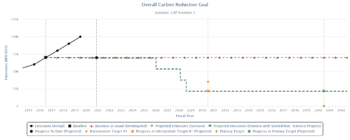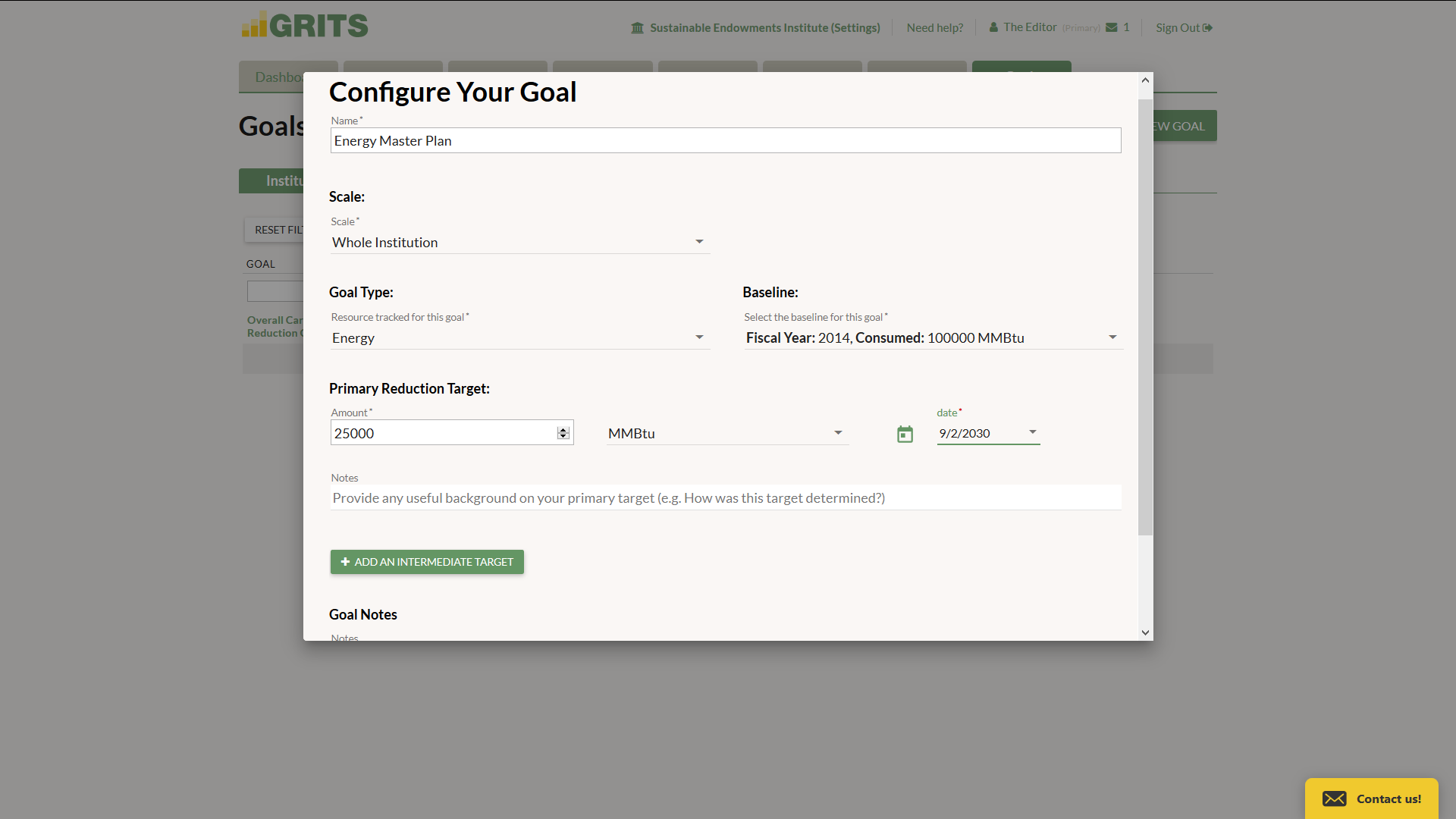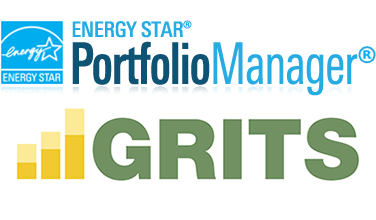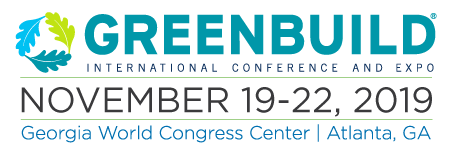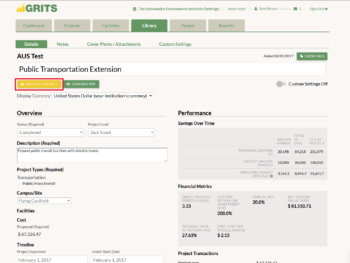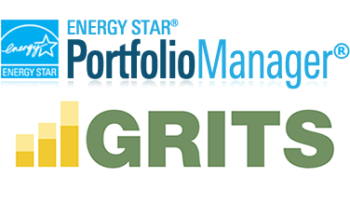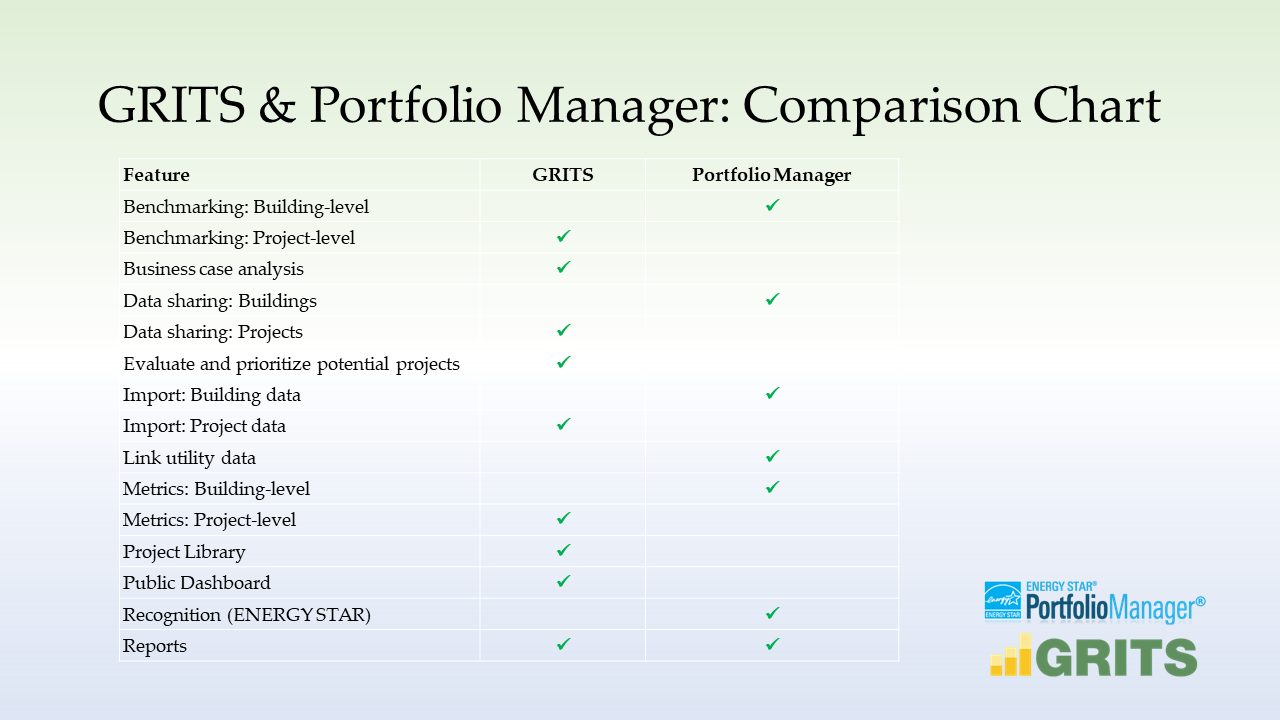GRITS Goals Launched: A Powerful New Tool for Climate and Energy Action Planning
Today we are excited to officially launch GRITS 4.0, headlined by GRITS Goals! This suite of features adds an entirely new dimension to GRITS, empowering users to develop detailed plans to meet both short-term and long-term carbon reduction and other resource efficiency targets. Goals is by far the largest expansion of the platform since we released GRITS 1.0 back in 2014.
Users are now able to quickly build climate action plan models or track an existing plan's impacts by assembling their projects into resource reduction scenarios at the institution-wide, campus/site, or building scale. GRITS Goals combines the platform’s business case analysis with customizable project timelines and dynamic charting to map out pathways from business-as-usual to aggressive energy, carbon, water, or waste reduction targets. Users will see the scenario's environmental impacts like average annual carbon and energy savings alongside financial metrics such as return on investment and total lifetime cost savings.
A huge thanks to our team (especially Aaron, Arvel and Deb), supporters, and users from over 800 institutions around the world that already use GRITS.
If you'd like to learn more or get access to GRITS Goals please contact us.
What's new in GRITS 4.0:
- Consumption tab
- Goals tab
- Goal Page
- Scenario Page
Consumption Tab
The Consumption tab is where you can enter your carbon emissions inventory as well as energy and water consumption and waste production data.
Goals Tab
The Goals tab is where you can set up a resource reduction task--reducing emissions, energy and water consumption, or waste production from a baseline amount to a target in the future. Add intermediate targets to help you stay on track.
Goal Page
The Goal page is where you can visualize the parameters of the goal you created in chart form.
Scenario Page
On the Scenario page you can quickly develop detailed climate action plan models or track an existing plan’s impacts by assembling your projects into resource reduction scenarios.
May Newsletter: Reconnecting During a Pandemic
Community Connections
We are all deeply affected by the COVID-19 pandemic. So much is in flux and our daily lives have been upended by stay-at-home advisories and travel restrictions. Practically all the schools using GRITS are closed and on-campus living experienced an early close this year. We hope you and your loved ones are able to stay safe.
Many of our users are key staff on university campuses, usually managing energy efficiency and other sustainability efforts. We have heard that some have been called into duty on the front lines of health & safety operations, participating in facility closures, emergency planning, and pandemic response measures. We wish these folks the best of luck and fortitude.
By working together, we will make it through the significant challenges we now face. Let us know if there’s anything we can help you with.
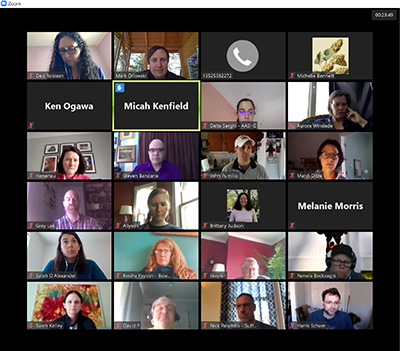
GRITS Goals
Coming Soon: The BIGGEST Enhancement to GRITS ever!
After years of optimization and incremental improvements, we have begun work on a dramatic expansion of the scope of the GRITS platform.
A new suite of features called “GRITS Goals” will empower users to develop detailed climate and sustainability action plans by assembling their projects into resource-reduction scenarios. You'll be able to build out a pathway to your institution’s targets for emissions, energy, water, waste, and even cost reduction.
Below is a sneak peek at a draft build of the GRITS Goals chart.
GRITS in Facilities Manager Magazine
We are proud to share a recent article about GRITS in Facilities Manager, the journal of APPA - Leadership in Educational Facilities. The article provides a succinct description of how GRITS supports facilities professionals and how it illustrates the impact of their work. Read descriptions of the case study webinars we have held over the past several months from Colgate University, Macalester College, City of Philadelphia, and the State of Vermont.
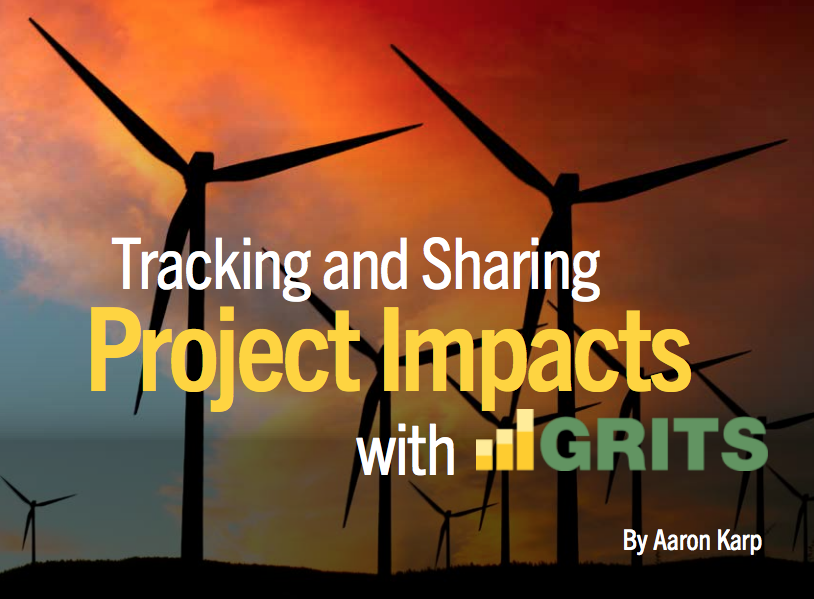
How can a stimulus bill create free money?
In 2009, $650k of ARRA money provided the University of New Hampshire an important seed investment for setting up their green revolving fund. The initial investment was used to upgrade their facilities, which lowered utility bills. Those savings were reinvested into more energy efficiency projects. Ten years later, over 50 projects have been financed through their GRF and resulted in more than $4 million in savings. This is what we hope to see in the coming years using pandemic response stimulus funding. Let us know if you anticipate setting up a revolving fund in the near future. Our parent organization, the Sustainable Endowments Institute, has a lot of resources on how to make it happen!

Let us know how we can partner with you to support your important work. You can reach out via our contact form.
New GRITS Article in Facilities Manager Magazine
We are proud to share a recent article about GRITS in Facilities Manager, the journal of APPA - Leadership in Educational Facilities. The article provides a succinct description of how GRITS supports facilities professionals and how it illustrates the impact of their work. The platform is easy to learn and use, and calculates a project’s financial and environmental impacts, including financial savings, emissions reduction, payback period, and net present value. Also described is the direct learning community fostered by GRITS and the Project Library where users can learn from each other’s successful efficiency projects.
The article also includes the stories of specific GRITS users and how they’ve leveraged project-tracking information to build a case for increasing investments in efficiency work, and how they’ve advanced sustainability in their portfolio of buildings. Details in the article include how GRITS has helped leaders at Colgate University, Macalester College, the City of Philadelphia, and the State of Vermont. Each has unique challenges and complex goals, and all are harnessing GRITS as a secure, web-based, collaborative tool to handle their project-level energy efficiency data. These are great examples of how a sustainability or facilities professional can move forward in their role.
APPA is an association of professionals dedicated to the safe and efficient operations of buildings, mostly on college & university campuses but in other settings as well. There are 321 different institutional members of APPA using GRITS across North America. These institutions have invested $156 million in efficiency projects tracked in GRITS and reaped over $881 million in savings. This is a great return on investment over hundreds of individual projects. Our platform helps these campuses understand and share their achievements.
Exploring the Public Library
The GRITS user community is an incredible group of people who are dedicated to energy efficiency and sustainability. The institutions they work for are continually making progress toward reducing emissions and resource use. Users can view thousands of sustainability projects in the private GRITS Library, a great resource for benchmarking and learning from others’ experiences.
But did you know there is a Public Library available to everyone, even those who don’t use GRITS? You can access it here and explore about 200 real projects from GRITS users who have enabled public sharing. Working on an HVAC upgrade? Lights? Pumps? Specialized equipment? Search for it and see what we have in the library. If you become a GRITS user you’ll then gain access to the full GRITS Library which includes data on more than 3,000 completed projects.
The GRITS community does tremendous work and you can be a part of it too. Contact us at support@gogrits.org to learn more about project tracking and sharing with GRITS!
December Newsletter: Is GRITS the perfect addition to your holiday menu?
Hello Everyone! We know you are tracking energy and sustainability progress, not just who’s been naughty or nice. We wanted to quickly share FREE resources that can support your sustainability work.
GRITS Goals: Building a Path Towards Carbon Neutrality
GRITS is already helping replace spreadsheets for tracking energy, financial, and carbon savings from users’ sustainability projects. We are now working to develop GRITS Goals, a new suite of features within GRITS that will empower users to develop detailed climate and sustainability action plans by assembling projects into resource reduction scenarios.
GRITS Goals will combine GRITS’ business case analysis, customizable project timelines, and dynamic charting to map out pathways from business as usual to aggressive energy, carbon, and other resource reduction targets. It will also help optimize project sequencing and execution timelines to allow for more precise planning.
GRITS Goals will measure users’ progress towards sustainability goals and include an optional live public dashboard displaying key progress metrics. This will be the largest single expansion of GRITS’ capabilities since its launch on Earth Day in 2014.
"Philly Skyline - South Street Bridge - Golden Hour" by hao$ is licensed under CC BY-NC-SA 2.0
Upcoming Webinar: Jan 15, 2020, 2pm Eastern
To learn more about GRITS and how to harness the power of an integrated project tracking platform, we encourage you to attend an upcoming webinar on the latest features in GRITS 3.5 along with a case study by the City of Philadelphia’s Dominic McGraw, Efficiency & Projects Manager. This webinar will provide insight into how a large municipal user sets up, monitors, and leverages GRITS to advance their energy efficiency goals. Register here!
Little Videos
We have some new short videos for you all! Take a look at this: a quick tour of how Colgate University has used GRITS to track their project savings. Here’s another - a great overview of how the Vermont State Energy Management Program has harnessed GRITS to simplify their GHG reduction efforts in Vermont.
3,000 Projects!
Look to the right side of this screenshot from our homepage: 3,000 Completed Projects! Our community of users across hundreds of campuses, municipal portfolios, and other collections of buildings—including many of you—have made a difference. Now take a look at the energy, financial, and carbon savings that have been achieved. Each project is adding up to our shared mission to reduce energy expenditure and move toward lower greenhouse gas emissions. Congratulations!
Social Media
We’re on Twitter! Send us your handles, or tweet at us @goGRITS - we would love to engage with you and share stories about resource efficiency projects. And to kick things off, we’d like to hear about how GRITS facilitates your sustainability work. One of the ways GRITS makes life easier is by eliminating the need for spreadsheets. Please share your stories with us on Twitter and tag it #ditchspreadsheets!
Here’s to a happy holiday season and to a great 2020! Cheers to you!
October Newsletter: GRITS is better for you than Halloween candy!
Greetings from the front lines of energy efficiency project tracking. We know you are busy, so we wanted to quickly share new free resources aimed at supporting your sustainability work and highlights from our community of users.
GRITS 3.5 is Live
We recently released the newest version of GRITS, headlined by the new Notification Center. You can now connect with other GRITS users through the platform and learn about their experiences with implementing projects. More than 800 institutions have access to GRITS through our partnerships or direct subscriptions. Read about the new features in this blog post.
Nearly 3,000 projects completed!
Our community of sustainability champions continue to add their work to the GRITS Project Library, a unique resource for benchmarking and inspiration. You can check out a selection of projects that they have shared in the GRITS Public Library here.
Green Revolving Funds for Airports
We are excited to share an important new resource with you: Revolving Funds for Sustainability Projects at Airports. Written in collaboration with the Rocky Mountain Institute, Cadmus, and Frasca & Associates, the report provides detailed guidance on how to set up a green revolving fund (GRF). Building on the success of GRFs at universities, the authors explore the relevance of this innovative financing model to the airport sector. While written with a focus on airports, nearly all of the content is also directly relevant to universities, K-12 schools, city/state governments and institutions in other sectors.
Portfolio Manager webinar recording available
In collaboration with the EPA’s ENERGY STAR Portfolio Manager program, we now offer a free basic GRITS account to Portfolio Manager users. A connection between the two platforms also allows you to quickly import your PM facilities into GRITS. If you haven’t already signed up for a free GRITS account as a Portfolio Manager user, you can do so through this form. You can watch a recording of the webinar here.
Green Schools webinar recording available
In August, through a partnership with the USGBC Center for Green Schools, we co-hosted a webinar to highlight how K-12 schools are using project-tracking tools like GRITS to achieve their sustainability goals. The webinar also featured an in-depth conversation of the green revolving fund model for internal funding of sustainability projects. You can tune in to see how it could work for your school or a school in your community here.
Attending Greenbuild 2019?
Are you attending Greenbuild in Atlanta this November? Our Founder and Executive Director, Mark Orlowski, will be presenting on a panel along with Katie Ross of Microsoft on “Using Internal Sustainability Funds to Drive ESG Performance.” The session is scheduled for Wednesday (November 20) from 4-5pm in Room B308.
We hope to see many of you at Greenbuild 2019!
Upcoming GRITS Demo Drop-ins
Are you interested in learning about GRITS through a live screen share tour? Come attend one of our Zoom webinars - please RSVP through this form.
- October 23 at 3pm EDT
- October 31 at 12pm EDT
- November 6 at 3pm EDT
- November 12 at 12pm EDT
Announcing GRITS 3.5!
Announcing GRITS 3.5!
GRITS 3.5 adds an entirely new feature—the Notification Center—which brings a new dimension to the platform: user-to-user connection and learning. Other developments include enhanced accuracy when calculating carbon savings and features that welcome UK institutions into the GRITS universe.
Keep reading for more details or log into GRITS now to see the upgrades for yourself!
P.S. Stay tuned over the next few months as several new features under development will dramatically expand GRITS’ capabilities for climate action planning at an institution-wide level!
New Developments in GRITS 3.5:
- Notification Center
- Clone Projects
- Several new features for users in the United Kingdom
- Additional resources with customizable emissions
- Unlimited users for free accounts
- Historical emissions factors
- New user welcome email
- New custom settings for indicating GRF repayment
- Portfolio Manager sync update
Notification Center
The new Notification Center in GRITS allows you to connect with other users via projects in the Library. When you click into another institution’s Project Detail page from the Library, you’ll now see a “Request Contact” button that will allow you to send a connection request to the Project Lead and most recently logged-in Primary user at that institution. If the request is accepted, GRITS will connect you with your counterpart via email, and from there you can discuss their experience with that project!

Access the Notification Center by clicking on the envelope icon at the top right-hand side of the page. The number of unread notifications appears to the right of the envelope icon. You can see pending connection requests on the Contacts sub-tab.
Another aspect of the Notification Center is that we’ll be able to let you know about new features via a notification within GRITS. You’ll receive an email alert about each new notification unless you turn off the email alert in the Preferences sub-tab.
Clone projects
If you’re planning to enter a project similar to one you’ve already added or simply wish to save time in the data entry process for your next project, you can now create a copy of the projects in your account--just click the “Copy” button on your Project Detail page. The copy will be generated in seconds. Copies of projects marked as Completed will be switched to the Proposed status so as to not immediately enter the Library.
Expanding GRITS to the UK
GRITS is now able to track projects undertaken at institutions in the United Kingdom, with several features added based on feedback from universities in the UK.
GRITS has added UK geography, allowing you to geolocate your facilities at UK addresses.
A new resource—heat—is available for selection under the resources being tracked and saved by projects entered into GRITS. This can be used for institutions reducing their use of district heating systems.
Heat has also been added to the resources whose emissions can be customized. Set up custom emissions factors to accurately calculate carbon savings from Heat projects.
All energy resources in GRITS can now have kWh as their unit of measurement.
Finally, kWh has been added as a platform-wide energy unit of measurement. Select kWh on your Settings page (by clicking on the name of your institution at the top of the page), under the Math, Units, and Stats sub-tab. This will convert energy savings throughout GRITS to kWh (on the Dashboard, Projects tab, Project Detail pages, the Library, and the Reports tab).
Additional resources with customizable emissions
Requests from users have resulted in the addition of natural gas and waste to the list of resources whose emissions can be customized. In the case of waste, you can now apply a custom carbon emissions factor to your waste-saving projects to have GRITS calculate the associated carbon savings.
Unlimited users for free accounts
If you use the free version of GRITS through any of our partnerships, you can now create log-ins for as many members of your team as you like. New users can be added on the People tab, or contact support@gogrits.org if you would like us to create several log-ins for you.
Historical emissions factors
GRITS now incorporates electricity emissions factors from past years when that data is available, so that your project’s carbon savings are derived from the factor for each individual year of its lifespan. This leads to a more accurate lifetime carbon savings calculation. To see the factors year-by-year, navigate to the Emissions Factors sub-tab of the Settings page and click the “historical emissions factors” link.
New user welcome email
Now you can ensure a new team member is aware of their GRITS access without sending them a separate message. Whenever you create a new GRITS log-in for a team member, you can have GRITS send them a welcome email informing them of their access and allowing them to create a custom password. Just leave the “Send Welcome Email” box checked, and upon clicking “Save” to create the new log-in GRITS will also email that person.
New custom settings for indicating GRF repayment
For those using GRITS in green revolving fund (GRF) mode: Previously, when indicating that you intend to pay back additional project savings to your GRF beyond the project cost, you could only set an institution-wide interest rate (extra repayments based on the outstanding project loan) or an institution-wide admin fee (an extra repayment based on a percentage of the project cost). These would be applied to every project. Now you can set up custom interest rates or admin fees for individual projects on the Custom Settings sub-tab on any Project Detail page. You can also apply both at the same time.
Portfolio Manager sync update
If you plan to import buildings from Portfolio Manager through GRITS’ connection to that tool, we have updated the process to accept building shares as soon as the import request is made in GRITS. This should eliminate issues that previously arose when trying to import buildings whose share request had not yet been accepted by the GRITS Webmaster account in Portfolio Manager.
Green Revolving Funds for Airports
We are excited to share an important new resource with you: Revolving Funds for Sustainability Projects at Airports. This report was funded and published by the U.S. federal government's Transportation Research Board under the National Academy of Sciences. While written with a focus on airports, nearly all of the content is also directly relevant to universities, K-12 schools, city/state governments and institutions in other sectors.
In collaboration with the Rocky Mountain Institute, Cadmus, and Frasca & Associates, we published a significant report that provides detailed guidance on how to set up a green revolving fund (GRF). Building on the success of GRFs at universities, this publication explores the relevance of this innovative financing model to the airport sector. The report is an accessible guide for any airport personnel looking to start a GRF.
From the report: “Many worthwhile airport sustainability actions are often not pursued because of a lack of funding. Airports may have a limited ability to pursue capital projects that are dedicated solely to increasing efficiency. Planning teams prioritize opportunities that support aircraft operations or enhance passenger terminal capacity. Operational budgets have limited potential to support new projects over other existing recurring expenses. A GRF solves these challenges by creating a dedicated funding stream for sustainability projects that does not compete with existing capital and operating budget priorities.”
Sustainable Endowments Institute, the creator of the GRITS platform, has worked with hundreds of universities with GRFs for over a decade. GRITS is designed to help institutions calculate and share revolving fund project data and keep track of fund finances. Airports have different needs than universities or municipalities, but the basic mechanism is the same. Take a look at the report to learn more.
Connecting to Schools: Partnering with the USGBC Center for Green Schools
School districts and campuses across the country who face annual budget cuts and unstable energy markets are finding it increasingly difficult to finance much-needed energy efficiency upgrades. The good news is that an innovative solution exists called the Green Revolving Fund (GRF). SEI has partnered with the USGBC Center for Green Schools to share an introductory webinar with interested parties.
You can watch the webinar here. Our expert presenters were: Kristen Trovillion, Sustainability Coordinator at Grand Rapids Public Schools (TrovillionK@grps.org) and Mark Orlowski, Executive Director and Founder of Sustainable Endowments Institute (mark@endowmentsinstitute.org). You will learn about the virtuous cycle of a GRF and the value that a dedicated internal capital fund could bring to your school system. Explore the Sustainable Endowments Institute’s industry-recognized resources such as our GRF Implementation Guide and GRITS software to manage renewable energy, energy efficiency, and other sustainability projects.
Green Revolving Fund Resources from SEI
- Billion Dollar Green Challenge & GRF resources
- Full Guide to GRF Implementation & Management
- Free Portfolio Manager sign up
- Free GRITS sign up for Portfolio Manager users
New Initiative with the EPA and ENERGY STAR Portfolio Manager
Thanks to our new initiative alongside the US Environmental Protection Agency’s Energy Star Portfolio Manager program, Portfolio Manager users can access a free version of GRITS and utilize this powerful tool to track and monitor energy efficiency and sustainability at their institution.
We recently hosted a webinar to share how existing Portfolio Manager users are benefiting from integrating GRITS into their processes.
The presenters included:
- Daniel Edson, State Energy Program Manager, Department of Buildings & General Services, State of Vermont.
- Brendan Hall, Public Sector Program Manager, ENERGY STAR Commercial & Industrial Branch at U.S. EPA.
- Mark Orlowski, Executive Director, Sustainable Endowments Institute, the Boston-based organization that developed GRITS.
The webinar highlighted the complementary benefits of the Portfolio Manager tool and the GRITS platform for tracking building-level and project-level data, respectively. It included presentations on both platforms as well as a case study from the State of Vermont as both a Portfolio Manager and GRITS user. You can watch the webinar here or view the comparison chart below that highlights the key features of both platforms.The GRITS tour starts around the 22:45 mark in the recording.
And here is the link for Portfolio Manager users to sign up for free access to GRITS.

